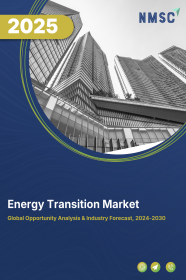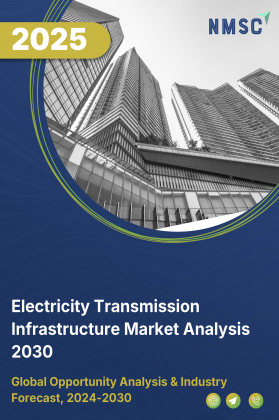
Energy Transition Market by Technology (Clean Power Generation, Energy Storage Systems, Grid & Digital Infrastructure, Electrification Technologies, Energy Efficiency Solutions, and Clean Fuels & CCUS), by Energy Source (Renewable Energy, and Non Renewable), by Application (Power & Utilities, Transportation, Industrial, Buildings, and Others)–Global Opportunity Analysis and Industry Forecast 2025-2030.
Energy Transition Market Overview
The global Energy Transition Market size was valued at USD 2.99 trillion in 2024 and is predicted to reach USD 5.15 trillion by 2030 with a CAGR of 9.5% from 2025-2030.
The factors such as inclination towards green energy usage, investment towards renewable energy sources and growing usage of electric vehicles drives the market growth. However, the high cost of clean and green energy inflates the price of energy transition industry. On the contrary, advancement in battery technology is improving energy storage, making renewable energy more reliable and accessible.
Moreover, top players namely, Tata Power Renewable Energy, Siemens Smart Infrastructure and others are taking initiatives involving collaborations and product launch in order to enhance their market position and expand product offerings. These initiatives are expected to drive innovations and adoption in energy transition market, creating an efficient digital ecosystem. Advancement in sustainable energy systems grows electric transport systems, grid stability and others. As the market matures, demand for energy transition is expected to grow steadily.
Inclination towards Green Energy Boosts Energy Transition Sector
The increasing focus on the use of green energy worldwide is driving the demand for government investments to reduce dependence on fossil fuels, stabilize markets, and promote a greener ecology, propelling the energy transition market expansion.
As per reports of the International Energy Agency (IEA),2023, governments invested USD 130 billion in clean energy for the year 2024. These efforts are accelerating the growth of the clean energy market, driving innovation, and accelerating the transition to sustainable energy faster.
Government Investments for Renewable Energy Heightens the Market
The expanding investments towards renewable technologies, namely solar, wind, and energy storage, lower costs and improve efficiency, making green energy more accessible. This accelerates adoption and the global shift toward sustainable energy systems and environmental goals.
According to recent reports in the International Energy Agency's Energy Technology Perspectives 2024 indicate that global energy investment will surpass USD 3 trillion for the first time in 2024, with USD 2 trillion directed towards clean energy technologies and infrastructure. Technological advancements in sustainable energy will reduce expenses, enhance efficiency, and aid in the energy transition market growth.
Growing Usage of Electric Vehicles Propels the Market
The growing desire for electric vehicles globally, grows the energy transition market demand by reducing fossil fuel usage. According to the International Energy Agency reports, 2023, the electric vehicle market is growing very fast in 2024. By 2023, the electric vehicle sales stood at about 14 million, and this makes the demand for electric vehicles promote the clean energy market. Consequently, it enhances the shift into more sustainable systems.
High Cost Hinders the Market Growth
The biggest hurdles to the expansion of the energy transition market are, high price of clean energy technologies and supply chain disruptions. The former slows down the progression of renewable energy projects, and the latter makes clean energy solutions costlier.
Advancement in Battery Technology Create Future Opportunities
The progress in battery technologies such as lithium-ion, solid-state, and flow batteries is transforming energy storage by enhancing capacity, efficiency, and longevity, thereby making renewable energy more dependable and available. These advancements are predicted to propel the broad acceptance of clean energy systems, creating considerable opportunities in areas such as grid stabilization, electric transportation, and decentralized energy solutions in the coming years.
Market Segmentations and Scope of the Study
The energy transition market report is segmented on the basis of energy source, technology, application and region. On the basis of energy source, the market is divided into renewable energy. Furthermore, renewable energy divisions focus on solar energy, wind energy, hydropower energy, geothermal energy and biomass. Based on technology, the market is segmented into power generation, energy storage, grid technology, carbon management, electrification technology and others. Moreover, on basis of application, the market is divided into residential application, commercial application and industrial application. Furthermore, the industrial application is further bifurcated into agricultural industry, oil and gas industry, mining industry, manufacturing industry, healthcare industry and others. Regional breakdown and analysis of each of the aforesaid segments includes regions comprising of North America, Europe, Asia-Pacific, and Rest of The World (Row).
Geographical Analysis
North America leads the energy transition market share and is likely to continue having a commanding position during the forecast period, driven by the rise in demand for solar energy in the region. According to the published report by World Resource Institute, 2024 clean energy in the U.S. made major steps with record levels of solar energy installations, increasing by 55% from 2023.
Solar energy adoption increases the demand for sophisticated energy storage solutions, such as batteries, that will manage its intermittent nature and ensure a stable power supply, enhancing the market growth.
Moreover, the governments' investment in this region toward clean energy reduces pollution, increases energy security, and protects the environment, boosting the energy transition industry. This helps in meeting climate goals and ensures a more sustainable future for communities, industries, and businesses.
As per the reports issued by the Government of Canada in 2024, the Canada government plans to make 90% of electricity produced in Canada from clean sources by 2030 and invest more in renewable energy infrastructure. The government is significantly investing in clean electricity to decrease emissions and achieve its climate targets.
On the other hand, the energy innovation market is expected to increase steadily during the forecast period in Asia-Pacific, driven by growth in electric vehicles that boost the transition from fossil fuels to cleaner sources of energy. IEA published a report in 2024 stating that by 2030, it is expected that nearly one in three cars in China will be electric, a significant boost to the energy innovation sector. Electric vehicle market are growing rapidly because of investments, supportive policies, and falling costs that accelerate the shift to cleaner energy.
Additionally, the growth of this region's health care is further propelling the demand for renewable energy so as to eliminate wastes, guarantee power supply in respect of the healthcare services, and even contribute towards preserving the environment.
According to reports published by the Ministry of Commerce and Industry, 2025, Indian healthcare grew sharply in 2023 at the valuation of 372 billion US dollars. A sector with tremendous growth of using renewable energy by the health sector to lower carbon emissions and establish a sustainable flow of reliable electricity for good services.
Competitive Landscape
Various key market players operating in the energy transition industry includes TNextEra Energy, Orsted, Iberdrola, Enel Green Power, Neoen, Siemens Energy, ABB, Eaton, GE Vernova, Air Liquide, Linde PLC, Plug Power, Nel ASA, Ballard Power Systems, Bloom Energy and others. These market players are adopting strategies such as collaboration and launches to remain dominant in the market.
For example, in March 2025, NextEra Energy, Launched its first utility-scale solar facility in Louisiana (100 MW capacity), CEO projected a 55% increase in global power demand over the next 20 years, with significant contribution from AI data centers.
In addition, in March 2025, Siemens Energy, Secured $1.6 billion contract to supply gas turbines for two low-emission plants in Saudi Arabia (3.6 GW total capacity). It Sold 90% of its Indian and Sri Lankan wind turbine operations to an investment group.
Built on the SICAM A8000 platform, it enhances efficiency of the grid while maintaining good cybersecurity standards. This launch contributes to renewable energy adoption by enhancing efficiency of the grid, preventing overload, and helping in the integration of renewable energy.
Key Benefits
-
The report provides quantitative analysis and estimations of the energy transition e market from 2025 to 2030, that assists in identifying the prevailing industry opportunities.
-
The study comprises a deep-dive analysis of the current and future energy transition market trends to depict prevalent investment pockets in the industry.
-
Information related to key drivers, restraints, and opportunities and their impact on the energy transition market is provided in the report.
-
Competitive analysis of the key players, along with their market share is provided in the report.
-
SWOT analysis and Porters Five Forces model is elaborated on the study.
-
Value chain analysis in the market study provides a clear picture of roles of stakeholders.
Energy Transition Market Key Segments
By Technology
-
Clean Power Generation
-
Solar Power (PV, CSP, Distributed Solar)
-
Wind Power (Onshore, Offshore)
-
Hydro Power (Large Hydro, Small/Micro Hydro)
-
Bioenergy (Biomass, Biogas, Biofuels)
-
Geothermal Energy
-
Nuclear (Fission, Small Modular Reactors, Fusion – emerging)
-
-
Energy Storage Systems
-
Batteries (Li-ion, Solid-state, Flow)
-
Mechanical (Pumped Hydro, CAES, Flywheels)
-
Thermal Storage
-
-
Grid & Digital Infrastructure
-
Smart Grids
-
Transmission & Distribution (T&D) Infrastructure
-
-
Electrification Technologies
-
EVs & Charging Infrastructure
-
Heat Pumps & Electrified Heating
-
Industrial Electrification
-
-
Energy Efficiency Solutions
-
High-efficiency Buildings & HVAC
-
Efficient Industrial Equipment
-
Smart Appliances & Controls
-
-
Clean Fuels & CCUS
-
Green Hydrogen & Derivatives (Ammonia, e-fuels)
-
Carbon Capture, Utilization & Storage (CCUS)
-
Synthetic Fuels / Biofuels (Advanced, SAF)
-
By Energy Source
-
Renewable Energy
-
Non Renewable
By Application
-
Power & Utilities
-
Utility-scale Projects
-
Distributed Generation (C&I)
-
Behind-the-Meter (Residential, Microgrids)
-
-
Transportation
-
Road (EVs, charging)
-
Aviation & Marine (SAF, e-fuels, hydrogen)
-
Rail (Electrification, hydrogen trains)
-
-
Industrial
-
Energy-intensive processes (steel, cement, chemicals)
-
Medium/low-intensity industries (food processing, textiles)
-
- Buildings
-
Residential
-
Commercial (offices, retail, hospitality)
-
Data Centers (separate category due to outsized impact)
-
-
Others
By Region
-
North America
-
The U.S.
-
Canada
-
Mexico
-
-
Europe
-
The U.K.
-
Germany
-
France
-
Italy
-
Spain
-
Denmark
-
Netherlands
-
Finland
-
Sweden
-
Norway
-
Russia
-
Rest of Europe
-
-
Asia-Pacific
-
China
-
Japan
-
India
-
South Korea
-
Australia
-
Indonesia
-
Singapore
-
Taiwan
-
Thailand
-
Rest of Asia-Pacific
-
-
Rest of the World (RoW)
-
Latin America
-
Middle East
-
Africa
-
Key Players
-
NextEra Energy
-
Orsted
-
Iberdrola
-
Enel Green Power
-
Neoen
-
Siemens Energy
-
ABB
-
Eaton
-
GE Vernova
-
Air Liquide
-
Linde PLC
-
Plug Power
-
Nel ASA
-
Ballard Power Systems
-
Bloom Energy
REPORT SCOPE AND SEGMENTATION:
|
Parameters |
Details |
|
Market Size in 2024 |
USD 2.99 Trillion |
|
Revenue Forecast in 2030 |
USD 5.15 Trillion |
|
Growth Rate |
CAGR of 9.5% from 2025 to 2030 |
|
Analysis Period |
2024–2030 |
|
Base Year Considered |
2024 |
|
Forecast Period |
2025–2030 |
|
Market Size Estimation |
Trillion (USD) |
|
Growth Factors |
|
|
Countries Covered |
28 |
|
Companies Profiled |
15 |
|
Market Share |
Available for 10 companies |
|
Customization Scope |
Free customization (equivalent to up to 80 working hours of analysts) after purchase. Addition or alteration to country, regional, and segment scope. |
|
Pricing and Purchase Options |
Avail customized purchase options to meet your exact research needs. |

















 Speak to Our Analyst
Speak to Our Analyst





















